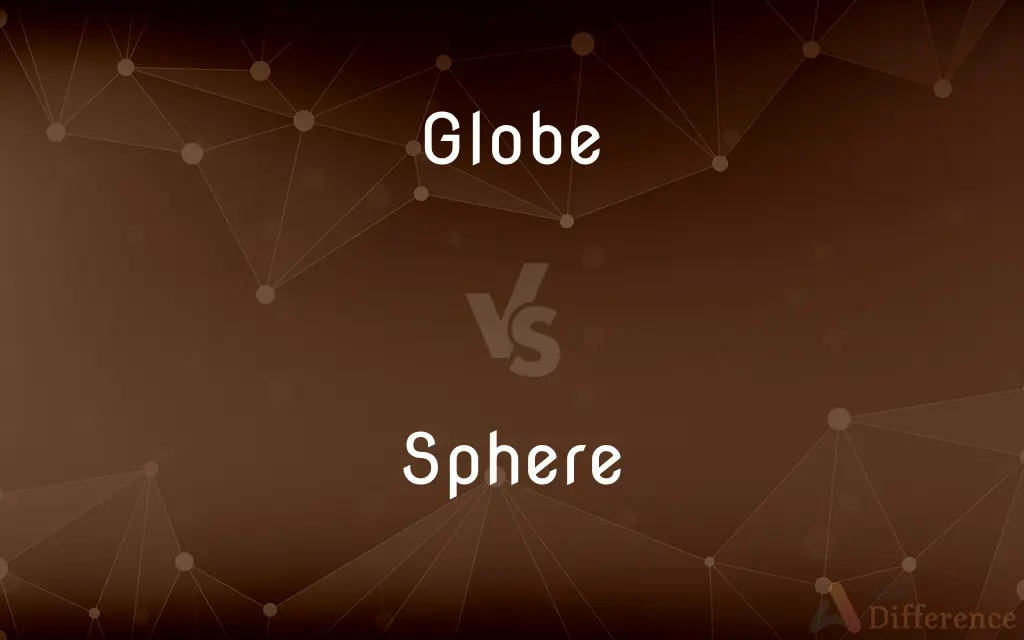Globe vs. Sphere — What's the Difference?
Edited by Tayyaba Rehman — By Maham Liaqat — Updated on July 29, 2024
A globe is a spherical model of Earth, representing geographical features, whereas a sphere is a three-dimensional shape where all points on the surface are equidistant from the center.

Difference Between Globe and Sphere
Table of Contents
ADVERTISEMENT
Key Differences
The globe is a specific representation of Earth, designed to depict continents, oceans, countries, and other geographical details on a spherical surface. It serves educational and decorative purposes, offering a physical model to understand Earth's geography and territorial divisions. A sphere, in contrast, is a geometric shape characterized by its perfect roundness, with every point on its surface being the same distance from its center. This definition encompasses more than just physical objects; it's a fundamental concept in mathematics and geometry, describing a three-dimensional solid in theoretical terms.
A globe is inherently a sphere due to its shape, but not all spheres are globes. The distinction lies in the globe's specific purpose to model Earth, complete with its surface details, whereas a sphere is a general term for any object or shape that meets the geometric criteria. This fundamental difference highlights the globe's role as an educational tool and the sphere's importance in mathematical and physical theories.
Both the globe and the sphere play crucial roles in their respective fields. The globe helps people visualize and understand the complexities of Earth's geography, promoting a global perspective. The sphere, meanwhile, is essential in scientific and mathematical discussions, providing a basis for exploring concepts of volume, area, and symmetry in three-dimensional space.
Understanding the distinction between these terms enriches our appreciation for the physical models that help us grasp our planet's geography and the geometric principles that govern the shapes and forms around us.
Comparison Chart
Definition
A spherical model of Earth depicting geographical features
A perfectly round three-dimensional shape
ADVERTISEMENT
Purpose
To represent Earth's geography for education and decoration
To describe a geometric shape in mathematics and physics
Representation
Specific to Earth's surface details
General geometric concept without specific details
Usage Context
Education, navigation, decoration
Mathematics, physics, everyday objects
Examples
Classroom globes, antique decorative globes
Planets, balls, bubbles
Compare with Definitions
Globe
A detailed spherical representation of Earth.
The teacher spun the globe to show us where Egypt is located.
Sphere
A perfectly round 3D shape with all points equidistant from the center.
A basketball is a good example of a sphere.
Globe
Used for educational purposes to study geography.
Students used the globe to learn about continents and oceans.
Sphere
Fundamental in geometry and physics.
The concept of a sphere is crucial in understanding planetary shapes.
Globe
Can be a decorative item with historical or artistic value.
An antique globe adorned the library, showcasing the world as known in the 18th century.
Sphere
Can represent celestial bodies in models.
In the solar system model, each planet is represented by a sphere.
Globe
Often mounted on a stand for easy rotation.
She rotated the globe on its axis to find Australia.
Sphere
Symbolizes completeness and unity in abstract concepts.
The sphere represents wholeness in many philosophical discussions.
Globe
Features geographical markings like countries and mountains.
The globe in our classroom has raised surfaces to indicate mountain ranges.
Sphere
Used to describe balls and spherical objects.
He kicked the sphere into the goal during the soccer game.
Globe
A globe is a spherical model of Earth, of some other celestial body, or of the celestial sphere. Globes serve purposes similar to maps, but unlike maps, they do not distort the surface that they portray except to scale it down.
Sphere
A sphere (from Greek σφαῖρα—sphaira, "globe, ball") is a geometrical object in three-dimensional space that is the surface of a ball (viz., analogous to the circular objects in two dimensions, where a "circle" circumscribes its "disk"). Like a circle in a two-dimensional space, a sphere is defined mathematically as the set of points that are all at the same distance r from a given point in a three-dimensional space.
Globe
The earth.
Sphere
A round solid figure, or its surface, with every point on its surface equidistant from its centre.
Globe
A spherical model of Earth or other planet.
Sphere
(mathematics) A regular three-dimensional object in which every cross-section is a circle; the figure described by the revolution of a circle about its diameter . Category:en:Surfaces
Globe
The earth; the terraqueous ball; - usually preceded by the definite article.
Sphere
A body or space contained under a single surface, which in every part is equally distant from a point within called its center.
Globe
A round model of the world; a spherical representation of the earth or heavens; as, a terrestrial or celestial globe; - called also artificial globe.
Sphere
To form into roundness; to make spherical, or spheral; to perfect.
Sphere
A three-dimensional closed surface such that every point on the surface is equidistant from the center
Common Curiosities
What makes a globe different from other spherical objects?
A globe specifically models Earth with geographical details, unlike other spherical objects that may not represent anything specific.
Are all globes the same scale?
No, globes come in various scales, but all aim to accurately represent Earth's geography relative to their size.
Is a globe always geographically accurate?
While globes strive for accuracy, historical or decorative globes may not reflect current geopolitical boundaries.
Can a sphere be hollow?
Yes, spheres can be both solid and hollow, as long as their surface is uniformly equidistant from the center.
How is a sphere used in mathematics?
In mathematics, a sphere is used to explore concepts of volume, surface area, and symmetry.
How are spheres important in science?
Spheres are important in science for modeling atoms, planets, and stars, and for understanding physical and geometric principles.
What materials are globes made from?
Globes are made from various materials, including plastic, paper, and metal, often coated over a spherical core.
Can digital models be considered globes?
Yes, digital or virtual globes represent Earth in a spherical format using geographic information systems (GIS).
How do you measure a sphere?
A sphere's size can be measured by its diameter, the distance through the center from one point on the surface to another directly opposite.
Can a sphere have any size?
Yes, a sphere can vary in size, but its defining feature is that all points on the surface are equidistant from the center.
Do globes rotate like Earth?
Globes can rotate on their stands, mimicking Earth's rotation, but the mechanism is manual or decorative.
Why can't flat maps be as accurate as globes?
Flat maps cannot accurately represent Earth's spherical shape, leading to distortions in area, shape, and distance.
Are there globes of planets other than Earth?
Yes, there are globes of other planets and moons, based on data from space exploration.
Why is a globe a more effective teaching tool than a flat map?
A globe provides a three-dimensional perspective, offering a more realistic view of Earth's shape and geographical relationships.
What is the significance of a globe's axis?
The globe's axis represents Earth's rotational axis, helping illustrate the concept of latitude, longitude, and time zones.
Share Your Discovery

Previous Comparison
Biter vs. Bitter
Next Comparison
Cay vs. IslandAuthor Spotlight
Written by
Maham LiaqatEdited by
Tayyaba RehmanTayyaba Rehman is a distinguished writer, currently serving as a primary contributor to askdifference.com. As a researcher in semantics and etymology, Tayyaba's passion for the complexity of languages and their distinctions has found a perfect home on the platform. Tayyaba delves into the intricacies of language, distinguishing between commonly confused words and phrases, thereby providing clarity for readers worldwide.













































